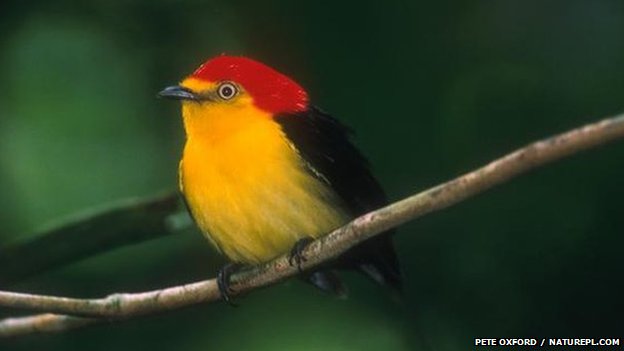AACC Aviculture Journal Archive
Click on the Journal image to view the journal

The REASON we Breed and Conserve BIRDS!

The wire-tailed manakin faces an uncertain future
Up to 900 tropical bird species could 'go extinct'.
By Anna-Louise Taylor Reporter, BBC Nature News
The finding is modelled on the effects of a 3.5C
Earth surface temperature rise, a Biological Conservation Journal paper shows.
Species may struggle to adapt to habitat loss and extreme weather events, author Cagan Sekercioglu says.
Mountain, coastal, restricted-range, and species unable to get to higher elevations could be the worst affected.
Depending on future habitat loss, each degree of surface warming could affect between 100-500 species, says Mr Sekercioglu,
assistant professor of biology at the University of Utah.
"This gives us a clear big picture. The problem is most species in the world are highly sedentary... the public perception
is most birds are migratory and so climate change is not a problem for them," he says.
Mr Sekercioglu says tropical mountain species are among the most vulnerable. He says bird species will need to be able to
adapt physiologically to changes in temperature and be able to move to higher altitudes if they are to survive.
He says cooler, more humid forests could recede higher up mountains and combined with human settlements at higher altitudes,
forest habitat could "get pushed off the mountain".
This would create "an escalator to extinction" he says.
"Coastal species are also vulnerable - as coastal forest can be sensitive to salinity, and these forests can get hit harder by
hurricanes and typhoons, and these events are also expected to increase."
Birds in extensive lowland forests with few mountains in places such as the Amazon and Congo basins - may have trouble
relocating, while tropical birds in open habitats such as savanna, grasslands, scrub and desert face shrinking habitats.
Tropical birds in arid zones are assumed to be resilient to hot, dry conditions, but they could suffer if water sources dry
out.
Mike Crosby, senior conservation officer in Asia at Birdlife International says: "We know that quite a lot of tropical birds
are not very good at dispersing so this could be a big issue in the future if the suitable climate moves several hundred
kilometres or even tens of kilometres, some of the birds might not be able to move their ranges sufficiently quickly in
response to that.
"We might have to take novel conservation measures in the future such as translocation of birds from one site to another."
The study looked at how manakins, of which there are 45 species in the neotropical region, would cope. Results showed that
manakins limited to the lowland habitats of the Amazon and Cerrado in Brazil, would be most affected as they could lose up
to 80% of their habitat; as many as 20% of the Cerrado manakin species are expected to go extinct.
Cagan Sekercioglu says: "Manakins show the importance of having a wide tropical area of mid-elevation forests, and being able
to move to higher elevation forests."
He says while overall "birds are one of the least threatened groups of animals" by climate change, "they are the 'best case'
scenario".
"The findings are likely to be much worse for all other groups of animals," he says.
"We need to be planning protected areas with higher elevations in mind and leave breathing room for endangered species in
higher elevation areas," says Mr Sekercioglu.
Mr Crosby says: "We've got to prepare ourselves to be measuring temperature in protected areas, and measuring rainfall, and
monitoring what's happening to species, so that we can respond in the appropriate way. It's very difficult to predict very
precisely what's going to happen."
He adds that visitors to the region could help protect the birds they travel to see.
"People who go bird watching in the tropics can gather very useful data, given that the current data that we have is basically
pretty poor in many parts of the world. Amateur bird watchers can really make an important contribution."
Source: http://www.bbc.co.uk/nature/17212765